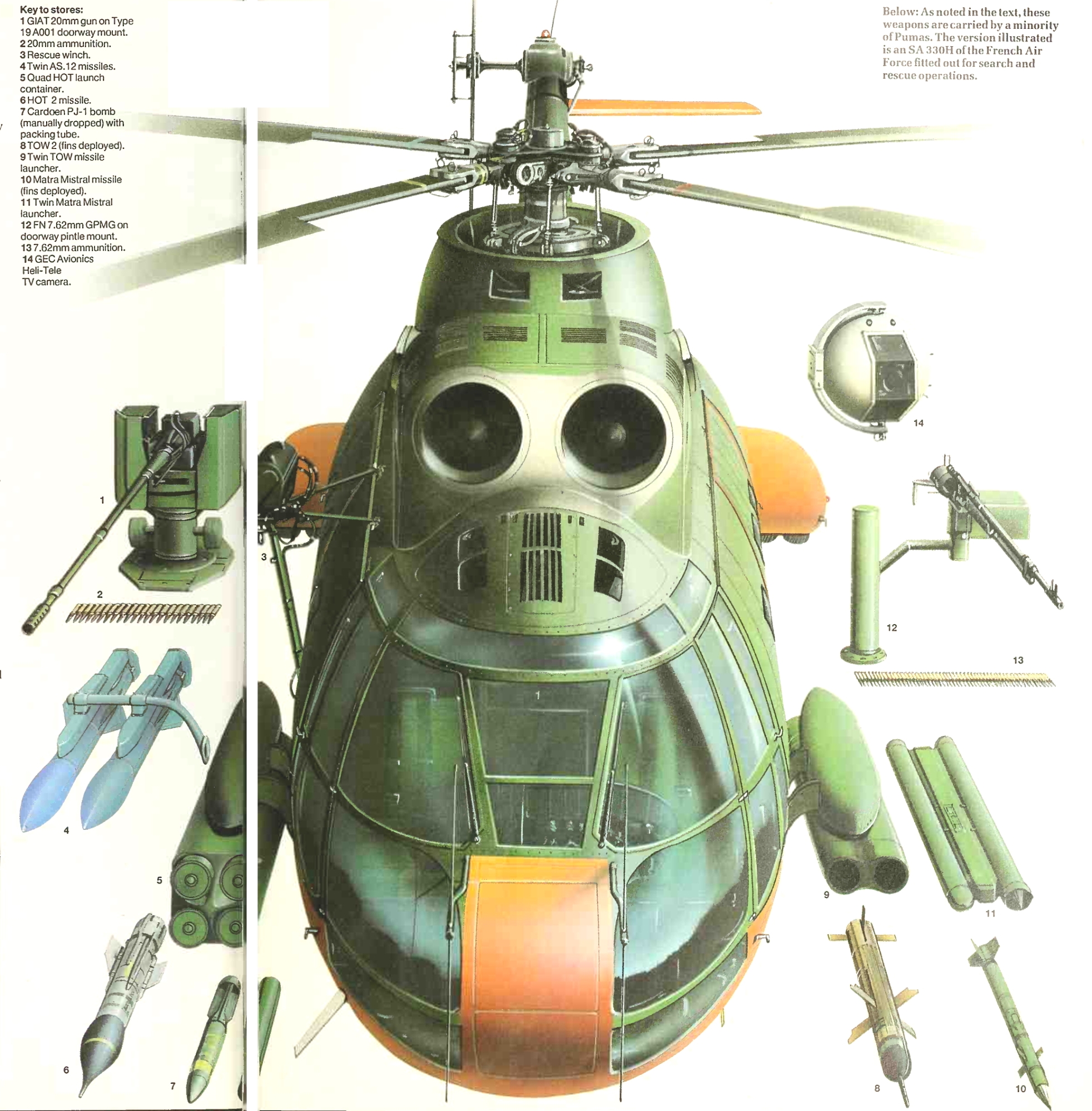
Puma
In 1962, the French Army issued a requirement for a French-produced tactical helicopter that could transport twenty soldiers and perform a variety of cargo-carrying duties. The SA 330 Puma, a completely new design, resulted. In 1963, with French government funding, the design process began; the first prototype flew in April 1965. The successful prototype resulted in an order for six preproduction machines. The Puma’s twin Bastan VII turbines were mounted on top of the fuselage, leaving the internal fuselage unobstructed for cargo, or for eighteen troops plus two pilots. Replacing the Bastan engines on production models, two Turbomeca Turmo 3C 1,320-horsepower turboshafts drove the 49- foot, 3-inch four-bladed main rotor and five-bladed tailrotor. The Puma exhibited a maximum speed of 150 knots and a range of 340 nautical miles.
Impressed by the Puma, both the French Army and the UK Royal Air Force placed substantial orders. On February 22, 1967, SudAviation entered into an agreement with Westland Helicopters to coproduce the Puma. Under the contract the companies jointly manufactured the SA 330 Puma, the SA 341 Gazelle, and the WG Lynx. Thus all Pumas were partially manufactured in England; Westland assembled completely the forty-eight HC1 Pumas ordered by the British military, and the first was delivered on July 30, 1968. The agreement that also allowed the French to build forty units of the Westland Lynx remained in force until 1988. On January 1, 1970, Sud-Aviation, Nord Aviation, and SEREB merged to form the Société Nationale Industrielle Aerospatiale, which honored all contracts previously signed with other manufacturers.
Several other countries purchased military variants of the Puma, including Chile, Indonesia, Morocco, South Africa, and Spain. Romania built the SA 330 under license as the IAR-330 and produced about ninety military and civilian models that were used by Romanian military and commercial operators, as well as the militaries of Ethiopia and Guinea. Established in 1963 as the major maintenance support for the South African Air Force (SAAF), Atlas Aircraft Company Ltd. completed a major modification of the SAAF Pumas, first known as the Gemsbok, then the Oryx. Atlas installed the more powerful Makila 1A turboshafts, new gearboxes, and extensive upgrades of weapon systems and avionics, including a nose-mounted radar. Atlas subsequently developed a gunship version of the Puma designated the ZTP-1 Oryx, on which the company installed external stub wings, with FFAR and machine gun pods, and a TC-20 20- mm cannon mounted under the fuselage. Bristow Helicopters also ordered a number of Pumas for off-shore work in the rough weather of the North Sea.
Super Puma
First flown in 1965, the Aerospatiale-designed “Puma-type” aircraft remained in production until 1987, but in 1974 the company initiated an improvement program that led to the AS 332 Super Puma. In September 1977 a prototype SA-331, equipped with an improved transmission and two 755-horsepower Turbomeca Makila turboshafts, completed its first test flight. On September 13 of the next year the prototype AS 332 Super Puma appeared with increased engine power and a more aerodynamically efficient fuselage. Aerospatiale engineers installed new composite main and tailrotors that increased lift efficiency, service life, combat survivability, and ended the problem of metallic blades corroding in maritime operations. The Super Puma featured an extended fuselage capable of hauling troops and cargo, a wider energy-absorbing retractable landing gear, armored seating for passengers and crew, and greater fuel capacity. The AS 332 reached a range of 532 nautical miles at maximum speeds of 141 knots. From 1978 until 1987 the company introduced five military and civilian variants of the 332, two with extended fuselages. In 1980 the 332 replaced the standard AS 330 Puma as the primary utility helicopter produced by Aerospatiale. The company manufactured 670 of the type, and the aircraft remained in limited production in Rumania into the twenty-first century.
Two fuel-efficient Turbomeca Makila 1,877-horsepower turboshafts turned the 51-foot, 2.2-inch four-bladed main rotor mounted atop the elongated rectangular fuselage, accommodating up to twenty-four troops. A longer tailboom and vertical fin supported a four-bladed composite tailrotor mounted on the starboard side and a horizontal stabilizer on the port. Depending on the version, in addition to more troops and twelve litters, or SAR equipment, the Super Puma could carry a 10,000-pound slingload, or an assortment of weapons for land or sea warfare. Weapons included gun pods for 7.62/.50-caliber machine guns, or 20-mm cannon and 70-mm FFARs. The ASW version carried a search radar in an extended nose, a dipping sonar, and homing torpedoes. For antiship operations the aircraft carried two AM 39 or MM 40 Exocet, BEA Sea Skua, or Harpoon missiles. Transport versions were armed with pintle-mounted 7.62-mm or .50-caliber doorguns. Bristow Helicopters Ltd., acquiring more than thirty aircraft for offshore operations in the North Sea and IPTN (Industri Pesawat Terbong Nasantara) in Indonesia, which also built the SA-330 under license, manufactured several Super Pumas for domestic civilian and military use. In all, thirty-eight countries bought variants of the AS 332-532, including Algeria, Argentina, Belgium, Brazil, Chad, Chile, China, Djibouti, Ecuador, France, Gabon, Germany, Iceland, Indonesia, Iraq, Ivory Coast, Jordan, Kenya, Kuwait, Lebanon, Libya, Malawi, Mexico, Morocco, Nepal, Nigeria, Oman, Pakistan, Panama, Philippines, Portugal, Senegal, Singapore, South Africa, Spain, Sudan, Switzerland, Togo, United Arab Emirates, the United Kingdom, and Zaire.